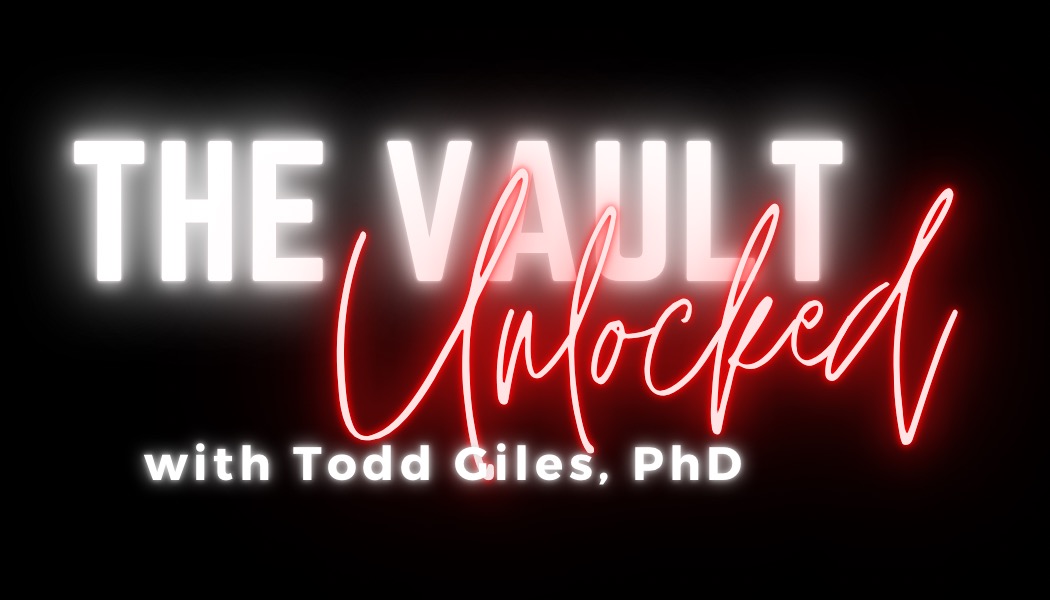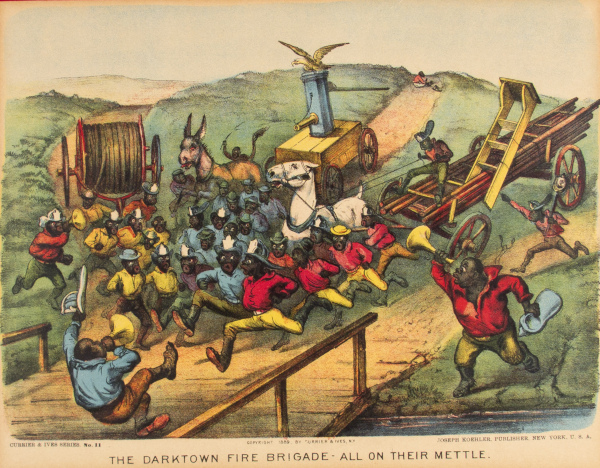
Ever wonder where the art is stored at the WFMA, and what's in there anyway? Join MSU professor Todd Giles as he unlocks the vault!

Currier & Ives
The Darktown Fire Brigade—All on Their Mettle, 1889
Lithograph
Gift of Dr. Joseph Knapp
This episode of The Vault Unlocked is part of the exhibition Visual Voice: Who Controls Black Representation? guest curated by Cammie Dean, MSU Texas Assistant Vice President for Student Affairs.
Works of art can be beautiful and unifying, capturing the best of what it means to be human; likewise, they can also be downright ugly and disagreeable. With time on our side, sometimes we see art very differently through our eyes than those of its original viewers. The important thing is that art makes us (re)consider our preconceived notions of self, our national identities and histories, and what it means to be human.
When one thinks of the names Currier & Ives (1857–1907), what comes to mind? For many older Americans, it is countless wintery scenes of warmly-clad white friends and families ice skating on frozen ponds and horse-drawn sleds pulling winter revelers through tree-lined country lanes as seen on countless Christmas cards, posters (and even dinnerware) for nearly two-hundred years now. As nostalgic as that might sound, these images, through their very lack of racial inclusion, also helped perpetuate the myth of who was and was not allowed to be considered a legitimate American.
Taking this idea to the extreme are the racially dehumanizing “Darktown Comics” produced by the same company. In the midst of the nation’s Reconstruction period following the Civil War, Currier & Ives commissioned several illustrators to design the “Darktown” series of lithographs which eventually numbered more than one hundred scenes capturing racist and nativist attitudes held by so many white Americans at the time. Reinforcing hateful stereotypes, the “Darktown” series depicts a segregated community of recently-freed African Americans engaging in roles traditionally held by whites, such as policemen, firefighters, opera singers, horse racers, and barbers. As shocking as it might sound today, this series was among Currier & Ives’ most popular. Indeed, even after the firm shut down in 1907, thousands more “Darktown” images were printed by publishers who purchased the original lithographic stones.
The “humor” of these prints is steeped in racist tropes that depict their characters not only as abject failures at everything they attempted to do, but also as lazy, ignorant and downright sub-human. The images are by any standards terribly offensive and inhumane; that’s the point—they were intended to perpetuate the belief that leadership, logic, and heroism existed only in the realm of the white male-dominant world.
The Darktown Fire Brigade—All on Their Mettle (1889) carries the vernacular subtitle “Git dere fust if you's bust you trousers!” Words and images matter; they both have the ability to be uplifting and loving or divisive and hateful. The Darktown Fire Brigade—All on Their Mettle, one of three lithographs in the series held in the permanent collection of the WFMA, depicts three fire companies haphazardly rushing to a fire at the same time from three different locations, apparently without forethought or planning. From the upper road we see the hose company in yellow uniforms; from the middle road, the engine company in blue; and along the lower road comes the ladder company in red. All three companies of men are rushing, mouths agape, to the narrow bridge where disaster is sure to occur in any moment. The leader of the hose brigade is unwittingly shouting his men into direct contact with the oncoming horse and mule; the leader of the engine brigade has fallen over backwards on the bridge, surely to be crushed by the rushing onslaught; and the leader of the ladder crew is about to take an unexpected bath in the river. It’s a disaster all around. That’s the message, pure and simple.
If the names Currier & Ives are thought of as the epitome of Americana, what then are we to make of this “Darktown” lithograph? Should museums like the WFMA sequester artworks like this away in their vaults never to be seen by today’s museumgoers, or is there something to be gained by presenting them in hopes of engaging folks in important critical conversations that are every bit as relevant in our world as they were when this works were created?
Works Consulted
Goldman, Judith. American Prints: Process & Proofs. Harper & Row Publishers, 1982.
Mayor, Hyatt and Donald H. Karshan et al. American Printmaking: The First 150 Years. Smithsonian Institution Press, 1969.
The Darktown Fire Brigade—All on Their Mettle from the Permanent Collection of the Wichita Falls Museum of Art at MSU Texas
View Previous The Vault Unlocked
-
Tuesday - Friday
10:00AM - 5:00PMSaturday
1:00PM - 5:00PM